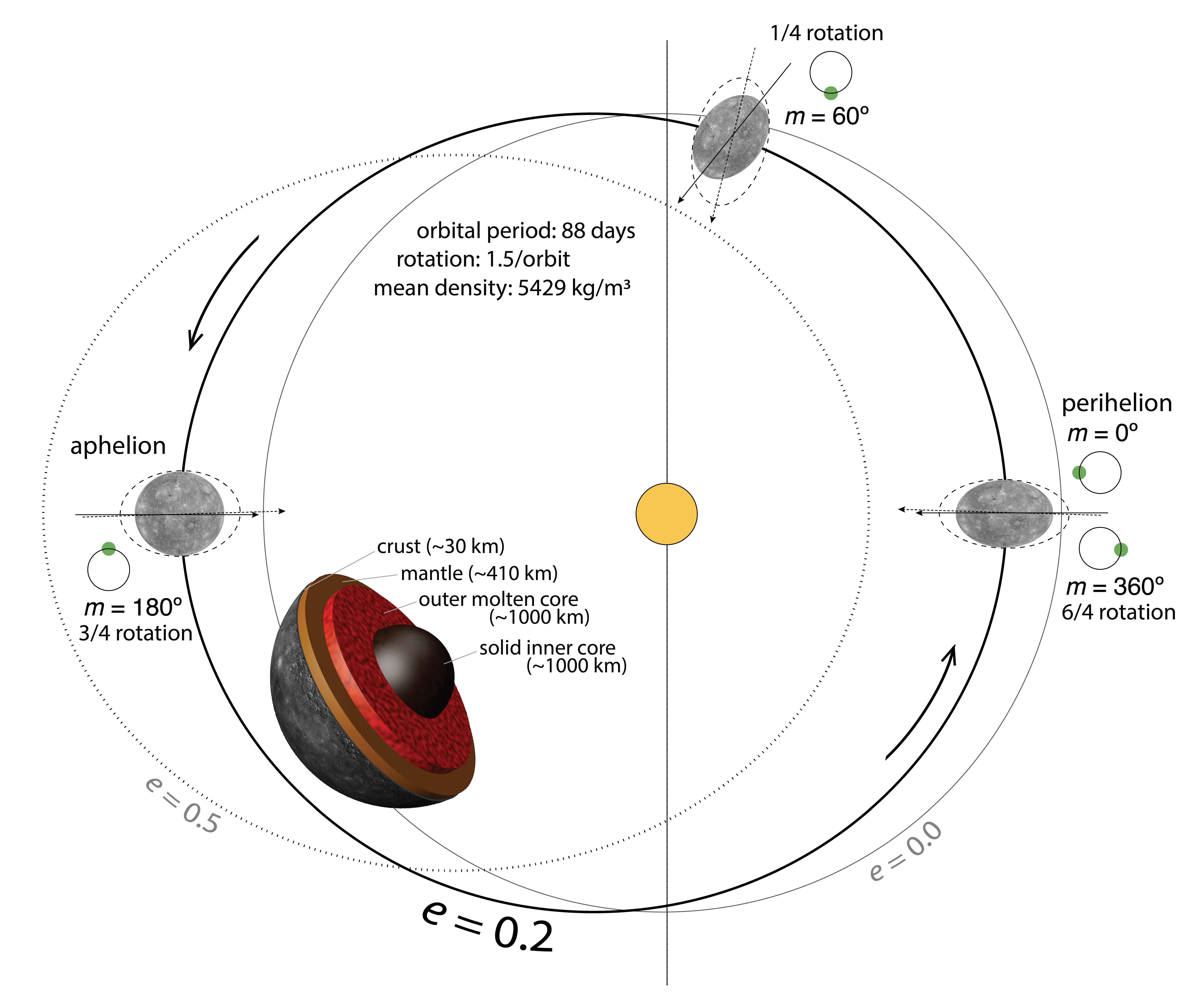Tidal forces from the Sun could have deformed cliffs on Mercury
A new study by researchers of the University of Bern shows that the hilly surface of Mercury could be influenced not only by the cooling and contraction of the planet, but also by the tidal forces of the Sun. Future analysis will draw on new data from the BepiColombo mission, which is currently on its way to Mercury. BepiColombo is a joint mission of the European Space Agency (ESA) and the Japan Aerospace Exploration Agency (JAXA). The University of Bern is involved with two instruments.
The surface of Mercury is characterized by hills and steep cliffs. Unlike Earth, Mercury has no tectonic plates that shift against each other. Instead, its crust is similar to a single solid shell. Hills and cliffs were largely formed because the planet cooled and shrank over time after its formation over 4.5 billion years ago.
As a planet cools, it usually contracts evenly with little sideways motion. However, close observations of Mercury show that its surface not only shrank but also shifted laterally, hinting that more complex internal and external forces are at play. A new study by Dr. Liliane Burkhard and Prof. Dr. Nicolas Thomas from the Space Research and Planetary Sciences Division at the Institute of Physics at the University of Bern now provides further explanations for the formation of these surface structures. In the new study, they show that Mercury's surface features were not only influenced by the planet’s cooling and contraction, but also by tidal forces related to Mercury's orbit around the Sun and its rotation around itself. The study has just been published in the Journal of Geophysical Research: Planets.
New clues from models of Mercury's orbit and rotation
Scientists have long been debating exactly how the fault patterns observed on Mercury, i.e. cracks and fracture lines in the rocky crust, were formed. Until now, it was assumed that Mercury’s tectonics were mainly a result of the cooling and contraction of the planet. But Mercury’s unique orbital behavior may also play a role.
The small planet in the immediate vicinity of the Sun is exposed to its enormous gravitational field and thus its tidal force. Mercury is locked in a 3:2 spin-orbit resonance, which means that it rotates three times around its axis for every two orbits around the Sun. In addition, its orbit is highly elliptical instead of circular, causing the tidal forces it experiences to vary periodically over time. The changing forces generate stresses within the crust, gradually deforming the surface and potentially influencing tectonic activity. "These orbital characteristics create tidal stresses that may leave a mark on the planet’s surface. We can see tectonic patterns on Mercury that suggest more is going on than just global cooling and contraction. Our goal was to investigate how tidal forces contribute to shaping Mercury’s crust," explains Liliane Burkhard, first author of the study.
Burkhard and Thomas created physical models of Mercury's interior, both present and past, and used these to calculate how the Sun's tidal forces could influence surface tensions over the last four billion years. "By changing parameters such as rotational speed and orbital eccentricity, we were able to simulate and deduce how Mercury's tectonics might have evolved," explains Burkhard.
The influence of the Sun
The research results show that the tidal forces of the Sun could have influenced the development and orientation of tectonic features on Mercury's surface over long geological periods of time. "Tidal stresses have been largely overlooked until now, as they were considered to be too small to play a significant role. Our results show that while the magnitude of these stresses is not sufficient to generate faulting alone, the direction of the tidally induced shear stresses are consistent with the observed orientations of fault-slip patterns on Mercury’s surface. This suggests that tidal stresses may have influenced the development and shear orientation of tectonic features over long geologic time periods. This is an aspect of Mercury's evolution that has not yet been explored," says Burkhard.
These results illustrate that even subtle forces such as the changing gravitational pull of the Sun can leave a lasting impression on a planet's surface. "Understanding how a planet like Mercury deforms helps us understand how planetary bodies evolve over billions of years," emphasizes Burkhard. These findings could also be applied to other planets in order to better understand their geological history and development.
Bernese participation in the BepiColombo mission
The researchers hope to gain further insights from the analysis of data from the BepiColombo mission of the European Space Agency (ESA) and the Japanese Space Agency (JAXA), which is currently on its way to Mercury. The University of Bern is involved in this mission with two instruments, including the laser altimeter BELA (BepiColombo Laser Altimeter), which was designed and built at the Physics Institute of the University of Bern with an international consortium. Nicolas Thomas is co-project leader, Liliane Burkhard instrument scientist for BELA.
In April 2018, BELA embarked on its 80 million kilometer journey to the planet Mercury on board the Mercury Planetary Orbiter, where it will arrive at the end of 2026. "BELA is a laser altimeter that will use laser pulses to measure the distance to Mercury's surface from an altitude of around 1,000 km with an accuracy of around 10 cm. Thanks to this data, we will be able to create a 3D image of Mercury's topography," says Thomas. Burkhard adds: "The data from BELA will help us refine the models for tectonic deformation and surface composition in order to draw an even more detailed picture of the geological processes on Mercury," concludes Burkhard.
Publication details:Liliane M.L. Burkhard & Nicolas Thomas. (2025). Exploring Mercury’s Tidal Stresses Through Time: Effects of Orbital Eccentricity, Rotational Dynamics, and Their Implications for Tectonics. Journal of Geophysical Research: Planets, 14.06.2025 URL: https://agupubs.onlinelibrary.wiley.com/doi/10.1029/2024JE008736 DOI: 10.1029/2024JE008736 |
About the BepiColombo missionLaunched on 20 October 2018, BepiColombo is a joint mission between the European Space Agency (ESA) and the Japan Aerospace Exploration Agency (JAXA), executed under ESA leadership. It is Europe's first mission to Mercury. It consists of two spacecraft, the Mercury Planetary Orbiter (MPO) designed and built by ESA and the Mercury Magnetospheric Orbiter (MMO) designed and built by JAXA. The two spacecraft are flying to Mercury together in a coupled system until they will reach Mercury's orbit. The MMO will then be placed in an ideal orbit to study in detail the magnetospheric interaction between the planet and the solar wind. The MPO will descend to an orbit of around 1,000 km, which is optimal for remote sensing of the planet's surface. More information about the mission on the ESA website Also on board BepiColombo are instruments that were designed and built at the Physics Institute of the University of Bern: The laser altimeter BELA and the novel mass spectrometer STROFIO. The BELA altimeter is one of the most important experiments on board the MPO. Its objective is to measure the shape, topography and morphology of Mercury's surface. BELA will provide the absolute height and position of the topography in a Mercury-centered coordinate system. The mass spectrometer STROFIO is part of SERENA on board the MPO. The objective of SERENA is the complete characterization of the particle populations, ions and neutrals, in the environment of Mercury under the influence of solar radiation and the solar wind. |
Bernese space exploration: With the world’s elite since the first moon landingWhen the second man, "Buzz" Aldrin, stepped out of the lunar module on July 21, 1969, the first task he did was to set up the Bernese Solar Wind Composition experiment (SWC) also known as the “solar wind sail” by planting it in the ground of the moon, even before the American flag. This experiment, which was planned, built and the results analyzed by Prof. Dr. Johannes Geiss and his team from the Physics Institute of the University of Bern, was the first great highlight in the history of Bernese space exploration. Ever since Bernese space exploration has been among the world’s elite, and the University of Bern has been participating in space missions of the major space organizations, such as ESA, NASA, and JAXA. With CHEOPS the University of Bern shares responsibility with ESA for a whole mission. In addition, Bernese researchers are among the world leaders when it comes to models and simulations of the formation and development of planets. The successful work of the Department of Space Research and Planetary Sciences (WP) from the Physics Institute of the University of Bern was consolidated by the foundation of a university competence center, the Center for Space and Habitability (CSH). The Swiss National Fund also awarded the University of Bern the National Center of Competence in Research (NCCR) PlanetS, which it manages together with the University of Geneva. |
2025/06/20




